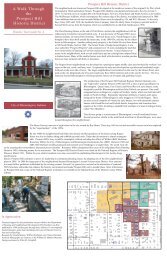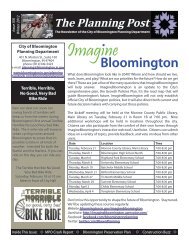Peak Oil Task Force Report - City of Bloomington - State of Indiana
Peak Oil Task Force Report - City of Bloomington - State of Indiana
Peak Oil Task Force Report - City of Bloomington - State of Indiana
You also want an ePaper? Increase the reach of your titles
YUMPU automatically turns print PDFs into web optimized ePapers that Google loves.
3. Explore school deconsolidation.<br />
From roughly the 1960s onward, the nation has embarked on a program <strong>of</strong> school<br />
consolidation wherein a number <strong>of</strong> traditionally neighborhood schools were consolidated<br />
in a single larger facility. The purpose <strong>of</strong> consolidation was to produce cost savings from<br />
economies <strong>of</strong> scale while also providing access to facilities and other aspects <strong>of</strong> pedagogic<br />
infrastructure that would otherwise not be available to students <strong>of</strong> smaller and more<br />
geographically dispersed schools.<br />
The promise <strong>of</strong> cost‐savings accruing from consolidation is a source <strong>of</strong> controversy. In any<br />
case, there are transportation costs associated with consolidation. With gasoline in the $2‐<br />
$3/gallon range, the Monroe County School Corporation is expending about 10% <strong>of</strong> its total<br />
budget operating its bus system, outsourcing some <strong>of</strong> that to private contractors. As fuel<br />
costs rise, the percentage <strong>of</strong> the school district’s revenue that must be diverted from<br />
education to transportation will increase. An investigation into cost savings, if any, realized<br />
by consolidation within the two major school corporations (Richland‐Bean Blossom and<br />
Monroe County Community Schools) should be conducted and those results contrasted<br />
against greater fuel and other transportation costs associated with de‐consolidation.<br />
4. Target public transit routes to help shape neighborhood development.<br />
Transit routes affect development patterns. The <strong>City</strong> should work with <strong>Bloomington</strong><br />
Transit (BT) to shape the quality and form <strong>of</strong> residential and commercial development by<br />
targeting bus routes and schedules both to foster neighborhood identity by naming routes<br />
or stops for neighborhoods. However, routes should only be expanded if and as BT<br />
achieves fuel efficiency greater than the current 29 passenger miles per gallon, which is<br />
actually worse than that <strong>of</strong> many fuel efficient private automobiles with a typical occupancy<br />
load. Better advertising, higher public awareness, and, above all, higher fuel prices will all<br />
probably result in increased transit ridership, which should, in turn, lead to better per‐<br />
rider fuel economy for the transit fleet. A discussion <strong>of</strong> public transit is more fully treated in<br />
the following chapter, Transportation.<br />
<strong>Report</strong> <strong>of</strong> the <strong>Bloomington</strong> <strong>Peak</strong> <strong>Oil</strong> <strong>Task</strong> <strong>Force</strong><br />
109









